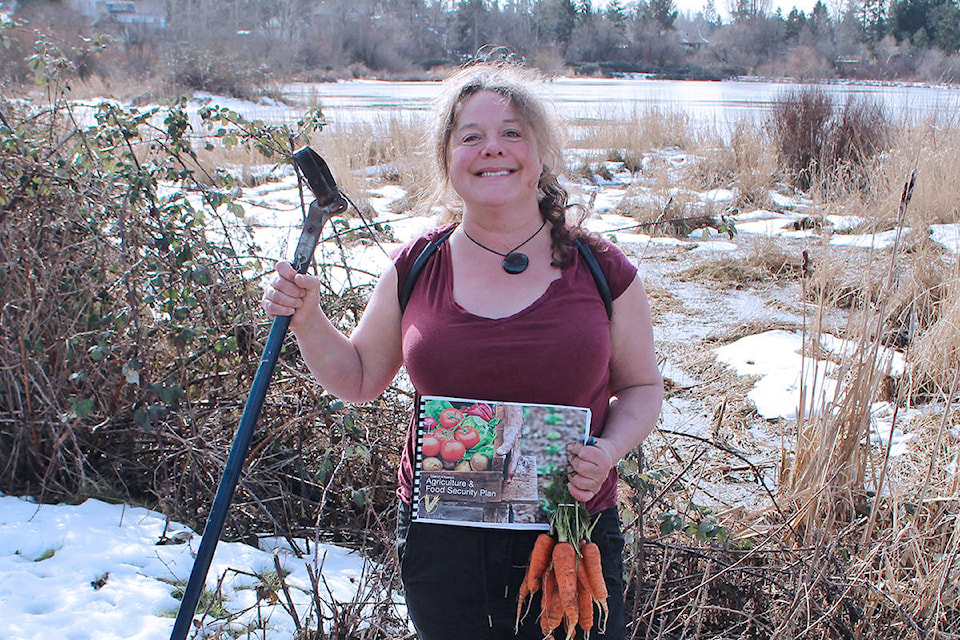Panama Flats can have a wetland bird sanctuary, a park and farmland, says a Saanich councillor.
Coun. Nathalie Chambers spoke this week in response to Mayor Fred Haynes’ suggestion that Panama Flats wetlands be preserved as a multi-use park in spite of the years-long agricultural plans.
Ten years after purchasing it for $2.4 million, Panama Flats is to be addressed Monday night at Saanich council. It was postponed from Jan. 21 to allow “further public input.” The land is 26 hectares, of which 8.5 is within the Agricultural Land Reserve.
The long-awaited proposal, recommended by staff, is to increase the ALR area to 23 hectares.
Farming the wetlands is not a concern for Chambers, who says flooding limits areas such as this to “summer squash” anyways.
“It doesn’t need to go in the ALR anyways, even if we can farm part of it,” said Chambers, adding there is a dire need to use some of the flats for farming, if only a few acres, assuming it’s done right.
| Former owners of Panama Flats, Island Berry Farm, building a dyke circa 2010 before selling the land to Saanich.(Black Press Media File Photo) |
READ ALSO: Saanich mayor, community call for the preservation of Panama Flats wetland
“I agree with the community that it should be preserved as a park and as a nature sanctuary for birds,” Chambers said. “And there should not be traditional farming here, which is a climate criminal. [But] agroecology is proven to enhance the wildlife.”
Saanich produced a 58-page draft plan for the Panama Flats in 2014 that identified its agricultural history and remaining potential. Chambers was among the many locals who put plenty of hours into Saanich’s 2018 Agriculture and Food Security Plan, a 78-page guide that also identifies portions of Panama Flats.
“There was always a plan for several uses here,” Chambers said.
Due to urban sprawl and pavement, the flats have become a defacto floodplain, likely more than it might have been originally, though historical records show it was farmed despite collecting water for the Colquitz watershed.
READ MORE: Saanich buys 62-acre Panama Flats for $2.4 million
John Edge of the Edge family said the low lands of the flats had flooding going back to farming in 1923. However, the amount of seasonal flooding grew over time. The Vantreight family had farmed the land dating back to the 1970s. In 1978 they had built a ditch, drainage system, and pumped water out. But in 2011, Ian Vantreight told the Saanich News that the flooding (which now permits for some of the finest outdoor skating this side of Kelowna) had drastically increased in the most recent 20 years and grown to the modern depths of a metre or more.
Now it’s about enhancing the wetlands even further, Chambers said.
“I can remember Ray Galey watching his potatoes float down the Colquitz River (from Panama Flats). That’s not the plan,” Chambers said, noting council has long recognized the low plains serve a crucial role as stormwater storage for the Colquitz and area.
The plan is to enhance the wetlands by enriching the soils in the higher ground through agroecology, and not with pesticides and prairie-style tractors, she said. And there are lots of farmers interested in farming this way, she added.
READ ALSO: Seven years later, Saanich still stalling on Panama Flats
Linda Geggie of Capital Regional Food and Agriculture Initiatives Roundtable said there is indeed interest in farming the land but not to pump and plow the floodplain. That would have a significant impact on the bourgeoning wildlife and bird populations, Geggie said.
Instead, CRFAIR, with Chambers’ support, suggests considering a smaller portion of the land away from the wetland area where small plots within a two- to five-acre area could support a group of new growers.
“We know this type of small plot agriculture is proving viable” Geggie said.
The Haliburton Farm organic model is a successful example of agroecology to protect ecosystems, grow food and develop successful farmers. Plots at Haliburton are sought after and this fall there were 29 applications for nine spots at the new Sandown Center for Regenerative Agriculture in North Saanich.
“These are young people, or people new to farming, who face the well-documented barriers to accessing land,” Geggie said.
Chambers agreed, noting she has had to turn away young people who want to learn at Madrona Farms, who want to mentor under her partner David Chambers’ tutelage.
“This will be parkland with the kind of farm you want next door. The food source that you want next door,” Chambers said.
Do you have a story tip? Email: vnc.editorial@blackpress.ca.
Follow us on Twitter and Instagram, and like us on Facebook.
